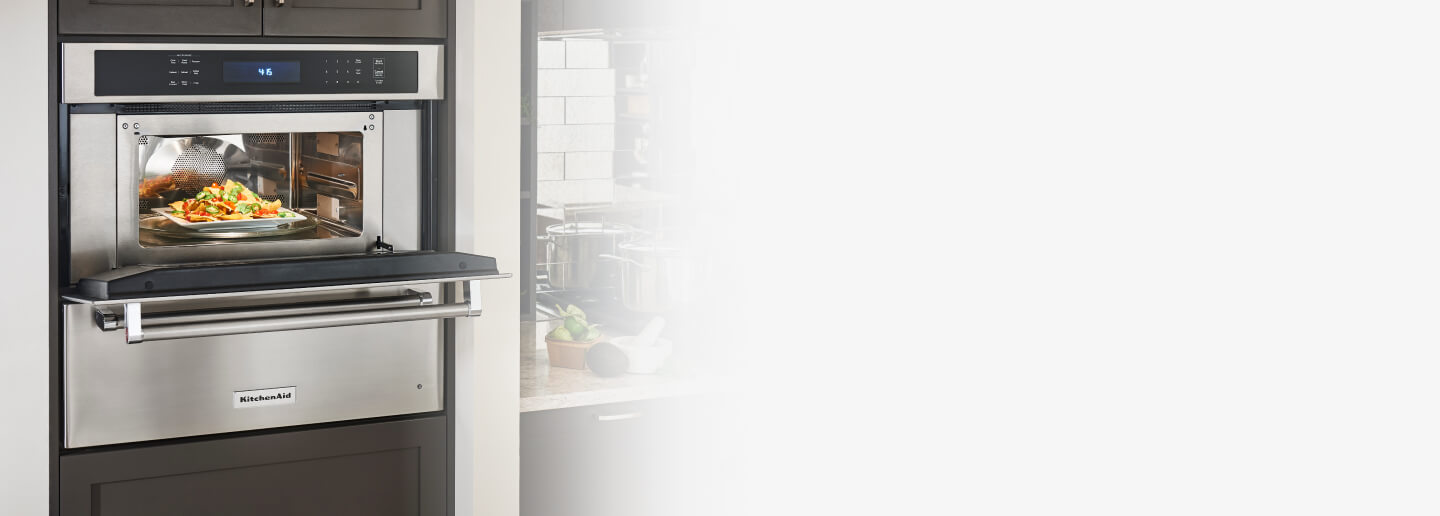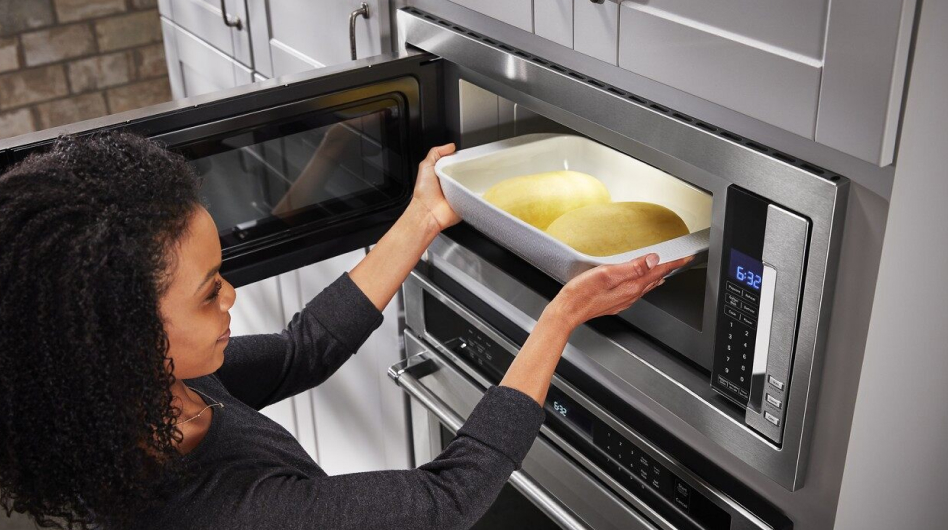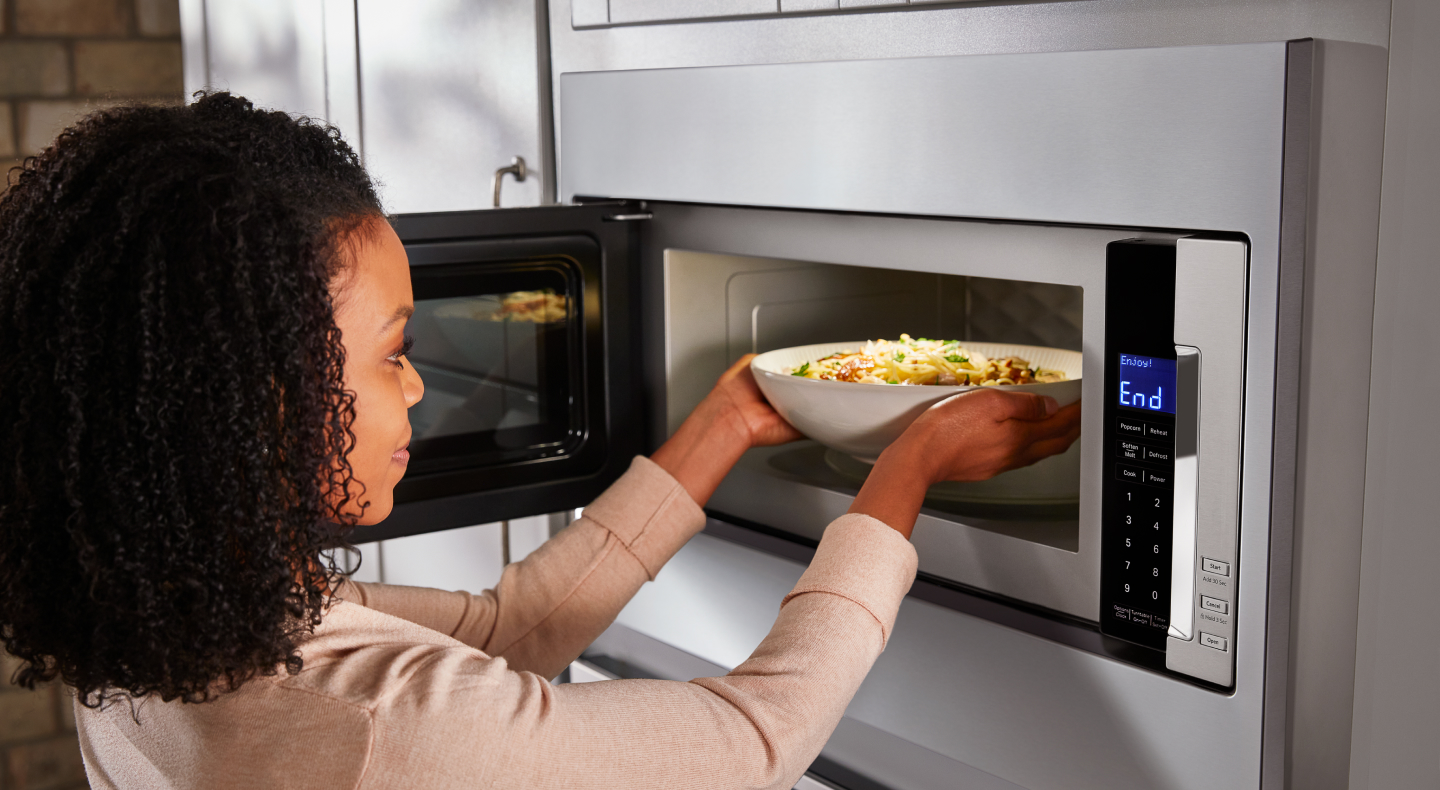
Built-in microwave buying guide
If counter space is at a premium in your kitchen, you can reclaim some precious work surface area and make more room to create. Opt for a microwave installation that is built-in or integrated with your kitchen cabinets, wall or island.
There are several ways to get the built-in look with a microwave in your kitchen, depending on the size, power and features you need, as well as the way you cook, bake and create. Use this article to learn what to consider when buying a built-in microwave, discover available built-in models and find features to help you explore your culinary curiosities.


What is a built-in microwave?
Built-in microwaves are designed to be installed into your kitchen cabinets or into a fixed wall to free up counter space and create an integrated look to your kitchen.
KitchenAid® built-in microwaves give your kitchen a custom look with appliances, cabinets and other fixtures working together in an integrated design. Plus, you don’t have to do a full kitchen remodel to enjoy the convenience and saved space that a built-in microwave oven provides. In many kitchen designs, you may be able to cut an opening or replace a single section of existing cabinetry to make room for a built-in model.
When shopping for a built-in microwave, consider the following:
Built-in microwave style
Built-in microwave dimensions
Built-in microwave features

KitchenAid® built-in microwaves
Seamless integration and professional design
Whether you need to reheat, steam or fully cook a meal, KitchenAid® built-in microwaves provide a versatile cooking space without taking up your counter space


Built-in microwave style
Built-in microwaves integrate into your kitchen by sitting within a cabinet, with some low profile and flush installation styles available to provide a seamless look. You can install the microwave at a comfortable height and in the location that best suits the way you use your kitchen space. Many people choose to place a built-in microwave oven near their wall oven, creating an easy way to move dishes from one to the other.
You can install a built-in microwave in various locations in your kitchen, as well as pick from several size and style options. Built-in microwaves offer three door options: right-to-left swing-out, drop-down or a slide-out drawer. The swing-out style is common in KitchenAid® countertop and over-the-range microwaves, while many built-in microwaves feature drop-down doors that open the same way as a traditional oven.
Learn more about microwave placement options.


Built-in microwave dimensions
Besides style, you can also choose the microwave size that fits your kitchen area best. When purchasing a built-in microwave for your kitchen, consider the width of the cabinet you want to install the appliance in. Built-in microwaves are usually available in 24-inch, 27-inch and 30-inch widths. Find out more about built-in microwave sizes.
If you’re trying to determine which size microwave will best fit your kitchen, consider where you are going to install the appliance and how you are going to use it. Kitchens with limited cabinet or wall space may benefit from 24-inch models like this KitchenAid® 24" Built-In Microwave Oven. If you have ample space and plan to use your microwave to heat family-sized meals, a 30-inch model like this KitchenAid® 30" Built-In Microwave Oven may be the right choice for you.


Built-in microwave features
When choosing a built-in microwave for your kitchen, be sure to consider the various available features to find one that will best match your making style. Here are a some built-in microwave features available on select KitchenAid® models:
- Timed defrost: Defrosting frozen foods in the microwave is often done by lowering the setting to 30-50% power and adjusting the time for the weight of the item being defrosted. With timed defrost, simply enter the weight and type of the frozen item, and the microwave will adjust the power and time to defrost without you having to do any math.
- Sensor cooking: Using temperature and humidity sensors, some microwaves may automatically adjust the time for optimal reheating, defrosting or cooking. These functions are often displayed on your microwave controls, with preset buttons such as “Popcorn,” “Potato” or “Auto Reheat.”
- Convection cooking: Your microwave oven can become a second oven or a combination oven if you opt for a model that includes convection cooking. In addition to reheating and cooking frozen meals, your microwave convection oven can now roast a chicken or bake cookies, doing double duty in your kitchen.
- EasyConvect™ Conversion System: Convection ovens use fans to circulate heated air. But most recipes don’t list temperatures and times for convection ovens. If your microwave has the EasyConvect™ Conversion System, like this KitchenAid® 30-inch Built-In Microwave Oven with Convection Cooking, it will convert the time and temperature to convection settings, making it easy to use with recipes of all kinds.
- Multifunction oven modes: Modern microwaves do so much more than reheat food. Select models are able to replace various countertop appliances and free up valuable space with functions like Baking, Roasting, Toasting and more. Some microwaves can also function like a second oven in your kitchen, with triple heating elements and a fan directing heat to cook at temperatures up to 450°F.
- Broil element: Imagine being able to finish your microwaved food with a quick broil to melt the cheese on top or add browning using the integrated Broil Mode. You can if your built-in microwave contains a broiling element.
- Air Fry mode: Using select microwave models to air fry food can be easy, convenient and helpful. You no longer have to pull out a separate appliance or lose counterspace to an air fryer. The triple-heating elements and fan circulate hot air around the included Air Fry Basket to crisp and brown food with less oil than traditional deep frying would use.
- Crispwave™ technology: Your microwave will do so much more than pop popcorn or melt butter if you have the crisper pan and Crispwave™ Technology to grill, fry, brown or crisp foods.
- Sensor steam/simmer cook cycle: Select microwave models feature a microwave cycle that allows precise steaming or simmering based on the food type and doneness level selected. Use this feature to help you prepare foods like vegetables, green beans, fish and more.
- PrintShield™ finish: This specialized coating for stainless steel resists smudges and fingerprints and is easy to clean with just water and a soft cloth.
Modern design: Sleek aesthetics and thoughtful design elements can be seen both on the exterior and interior of built-in microwaves. The built-in design gives your microwave a seamless look by aligning with cabinetry, while professional-inspired design throughout the interior and exterior of select models, like Backlit Touch Controls and textured handles, elevate the look of your appliance.
Smart capabilities: Select microwaves can help you stay in control of your kitchen from anywhere, with hands-free voice control accessibility and notifications sent to your smart devices.

KitchenAid® built-in microwaves
Seamless integration and professional design
Whether you need to reheat, steam or fully cook a meal, KitchenAid® built-in microwaves provide a versatile cooking space without taking up your counter space
Shop KitchenAid® built-in microwaves with smart capabilities
A smart microwave can help you do more in the kitchen. A KitchenAid® smart microwave can help you remotely preheat, monitor and control the microwave oven with the KitchenAid™ App or with simple voice commands through your Google Assistant or an Alexa-enabled device, leaving your hands free to create.*
*WiFi & App Required. Features subject to change. Details & privacy info at kitchenaid.com/connect (USA) or kitchenaid.ca/connect (Canada). Appliance must be set to Remote Enable. Google® is a trademark of Google LLC. Alexa is a trademark of Amazon.com, Inc. or its affiliates.


What is the difference between over-the-range and built-in microwaves?
Over-the-range microwaves are almost always installed over your stove or cooktop as they often combine the microwave with a range hood and a stove light, while built-in microwaves can be installed almost anywhere in your kitchen.
It’s easy to replace the microwave you already have with another model that is the same size and style, as you won't need to do any remodeling to make room. Over-the-range microwaves can often be installed in place of an existing range hood in your kitchen. And, if you already have an over-the-range microwave that is past its prime or simply no longer meets your needs, KitchenAid brand has a range of microwave hood combinations to choose from.


What is the difference between a countertop and built-in microwave?
The main difference between countertop and built-in microwaves is the installation. Countertop models are installed on your kitchen counters by simply plugging the appliance into a nearby outlet, while built-ins are installed directly into cabinets or walls in your kitchen. Learn more about different types of microwave ovens.
Can any microwave be built-in?
You can mount your countertop microwave on a shelf or in a cabinet for a built-in look to conserve space. Trim kits from KitchenAid brand allow you to close gaps around the appliance to help create a seamless finish.


What is an undercounter microwave oven drawer style?
One way to add a built-in microwave to your kitchen is with an undercounter microwave drawer. These top-loading appliances are installed in your lower cabinets so they’re easy to reach, and they’re also tucked out of the way, allowing for additional storage space in your upper cabinets.
Microwave drawers open like a cabinet drawer. The drawer design of undercounter microwave ovens makes it easy for you to check or stir foods during cooking, and then place the dish on the countertop once you’ve removed it from the microwave.
The Auto Touch Open/Close feature on the KitchenAid® 24" Undercounter Microwave Drawer lets you push a button to open and close the microwave drawer, giving you effortless access even with your hands full. With a 1.2 cu. ft. capacity and 950 watts, you’ll be able to cook, reheat and defrost your favorite foods, including deep bowls or tall glasses. This undercounter microwave design includes Sensor Functions that allow you to choose from a menu of 10 foods you microwave most, with a sensor to detect humidity to optimize the cook time. The Keep Warm Function lets you keep your food warm until it’s ready to be served.


Is a built-in microwave worth it?
You may want to consider opting for a built-in microwave if you prefer your countertops to be uncluttered. Built-in microwaves can open up your kitchen counters to provide more room to create.
If your kitchen has limited cabinet space, or if you live in a rental unit that doesn’t allow you to remodel, a countertop microwave might be a better choice.


Do built-in microwaves need to be vented?
Yes, built-in microwaves require adequate ventilation. The amount of cabinet depth required for proper ventilation can vary by model, but is typically about 15–22 inches.
Not sure which microwave you should buy for your kitchen? Explore this microwave buying guide to learn about some of the features and factors to consider when choosing a microwave.
Shop KitchenAid® built-in microwaves
If you’re looking to upgrade your kitchen aesthetic with seamless integration while enhancing your meal preparation, a KitchenAid® built-in microwave may be the perfect fit. Whether you need to reheat, steam or fully cook a meal, a built-in microwave oven can bring versatility and extra cooking space to your kitchen.
.png?fit=constrain&fmt=jpg&wid=2875)
Get more with a KitchenAid account
Sign in and explore

built-in kitchen appliances
Sleek & seamless designs to inspire
Built-in appliances align with your cabinetry to blend in with your style or stand out as a statement.